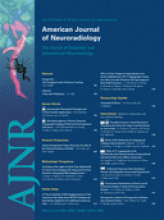Research ArticleFunctional
Open Access
Tactile Sensory and Pain Networks in the Human Spinal Cord and Brain Stem Mapped by Means of Functional MR Imaging
N.F. Ghazni, C.M. Cahill and P.W. Stroman
American Journal of Neuroradiology April 2010, 31 (4) 661-667; DOI: https://doi.org/10.3174/ajnr.A1909
N.F. Ghazni
C.M. Cahill

References
- 1.↵
- Meyer R,
- Ringkamp M,
- Campbell J,
- et al
- 2.↵
- Creac’h C,
- Henry P,
- Caille JM,
- et al
- 3.↵
- Hansson T,
- Brismar T
- 4.↵
- Blatow M,
- Nennig E,
- Durst A,
- et al
- 5.↵
- Dunckley P,
- Wise RG,
- Fairhurst M,
- et al
- 6.↵
- Fairhurst M,
- Wiech K,
- Dunckley P,
- et al
- 7.↵
- 8.↵
- Madi S,
- Flanders AE,
- Vinitski S,
- et al
- 9.↵
- Stracke CP,
- Pettersson LG,
- Schoth F,
- et al
- 10.↵
- Yoshizawa T,
- Nose T,
- Moore GJ,
- et al
- 11.↵
- Komisaruk BR,
- Mosier KM,
- Liu WC,
- et al
- 12.↵
- Stroman PW,
- Kornelsen J,
- Bergman A,
- et al
- 13.↵
- 14.↵
- Stroman PW,
- Krause V,
- Malisza KL,
- et al
- 15.↵
- Stroman PW
- 16.↵
- Agosta F,
- Valsasina P,
- Caputo D,
- et al
- 17.↵
- Stroman PW
- 18.↵
- Stroman PW,
- Kornelsen J,
- Lawrence J
- 19.↵
- Stroman PW,
- Tomanek B,
- Krause V,
- et al
- 20.↵
- Field MJ,
- Bramwell S,
- Hughes J,
- et al
- 21.↵
- Rainville P,
- Feine JS,
- Bushnell MC,
- et al
- 22.↵
- 23.↵
- 24.↵
- McGonigle DJ,
- Howseman AM,
- Athwal BS,
- et al
- 25.↵
- Friston KJ,
- Ashburner JT,
- Kiebel SJ
- 26.↵
- DeArmond SJ,
- Dewey MM,
- Fusco MM
- 27.↵
- Tamraz JC,
- Comair YG
- 28.↵
- Kimberley TJ,
- Lewis SM
- 29.↵
- Leitch J,
- Cahill CM,
- Ghazni N,
- et al
- 30.↵
- Stroman PW
- 31.↵
- Ochoa JL,
- Yarnitsky D
- 32.↵
- Yezierski RP,
- Wilcox TK,
- Willis WD
- 33.↵
- Besson JM
- 34.↵
- Willis WD,
- Westlund KN
- 35.↵
- Gardner E,
- Marin J,
- Jessel T
- 36.↵
- Kennedy PR
- 37.↵
- Baumeister AA,
- Anticich TG,
- Hawkins MF,
- et al
- 38.↵
- 39.↵
- Fields HL,
- Basbaum AI,
- Heinricher MM
- 40.↵
- Monhemius R,
- Green DL,
- Roberts MH,
- et al
- 41.↵
- Sillery E,
- Bittar RG,
- Robson MD,
- et al
- 42.↵
- Waters AJ,
- Lumb BM
- 43.↵
- 44.↵
- Menon RS,
- Ogawa S,
- Kim SG,
- et al
- 45.↵
- Ogawa S,
- Tank DW,
- Menon R,
- et al
- 46.↵
- McKiernan KA,
- Kaufman JN,
- Kucera-Thompson J,
- et al
- 47.↵
- Liu WC,
- Feldman SC,
- Cook DB,
- et al
- 48.↵
- 49.↵
- Schweinhardt P,
- Glynn C,
- Brooks J,
- et al
- 50.↵
- Witting N,
- Kupers RC,
- Svensson P,
- et al
- 51.↵
- Witting N,
- Kupers RC,
- Svensson P,
- et al
- 52.↵
- Peyron R,
- Schneider F,
- Faillenot I,
- et al
- 53.↵
- Kiernan JA,
- Barr ML
- 54.↵
- Willis WD,
- Coggeshall RE
- 55.↵
- Carpenter MB
In this issue
Advertisement
N.F. Ghazni, C.M. Cahill, P.W. Stroman
Tactile Sensory and Pain Networks in the Human Spinal Cord and Brain Stem Mapped by Means of Functional MR Imaging
American Journal of Neuroradiology Apr 2010, 31 (4) 661-667; DOI: 10.3174/ajnr.A1909
0 Responses
Jump to section
Related Articles
- No related articles found.
Cited By...
This article has been cited by the following articles in journals that are participating in Crossref Cited-by Linking.
- Clas Linnman, Eric A. Moulton, Gabi Barmettler, Lino Becerra, David BorsookNeuroImage 2012 60 1
- Petra Schweinhardt, M. Catherine BushnellJournal of Clinical Investigation 2010 120 11
- C.A. Wheeler-Kingshott, P.W. Stroman, J.M. Schwab, M. Bacon, R. Bosma, J. Brooks, D.W. Cadotte, T. Carlstedt, O. Ciccarelli, J. Cohen-Adad, A. Curt, N. Evangelou, M.G. Fehlings, M. Filippi, B.J. Kelley, S. Kollias, A. Mackay, C.A. Porro, S. Smith, S.M. Strittmatter, P. Summers, A.J. Thompson, I. TraceyNeuroImage 2014 84
- Yazhuo Kong, Mark Jenkinson, Jesper Andersson, Irene Tracey, Jonathan C.W. BrooksNeuroImage 2012 60 2
- Jocelyn M. Powers, Gabriela Ioachim, Patrick W. StromanBrain Sciences 2018 8 9
- Jürgen Finsterbusch, Christian Sprenger, Christian BüchelNeuroImage 2013 79
- Cheryl Sparks, Joshua A. Cleland, James M. Elliott, Michael Zagardo, Wen-Ching LiuJournal of Orthopaedic & Sports Physical Therapy 2013 43 5
- Ian Appleyard, Thomas Lundeberg, Nicola RobinsonEuropean Journal of Integrative Medicine 2014 6 2
- Gemma Lamp, Peter Goodin, Susan Palmer, Essie Low, Ayla Barutchu, Leeanne M. CareyFrontiers in Neurology 2019 9
More in this TOC Section
Similar Articles
Advertisement











